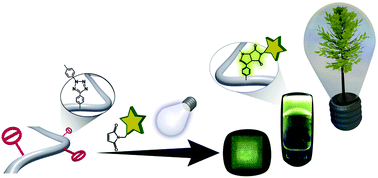当前位置:
X-MOL 学术
›
Mater. Horiz.
›
论文详情
Our official English website, www.x-mol.net, welcomes your
feedback! (Note: you will need to create a separate account there.)
Photochemical ligation meets nanocellulose: a versatile platform for self-reporting functional materials
Materials Horizons ( IF 12.2 ) Pub Date : 2018-04-07 , DOI: 10.1039/c8mh00241j Daniel Hoenders 1, 2, 3, 4, 5 , Jiaqi Guo 1, 2, 3, 4, 5 , Anja S. Goldmann 6, 7, 8, 9, 10 , Christopher Barner-Kowollik 6, 7, 8, 9, 10 , Andreas Walther 1, 2, 3, 4, 5
Materials Horizons ( IF 12.2 ) Pub Date : 2018-04-07 , DOI: 10.1039/c8mh00241j Daniel Hoenders 1, 2, 3, 4, 5 , Jiaqi Guo 1, 2, 3, 4, 5 , Anja S. Goldmann 6, 7, 8, 9, 10 , Christopher Barner-Kowollik 6, 7, 8, 9, 10 , Andreas Walther 1, 2, 3, 4, 5
Affiliation

|
The sustainable origin and highly promising mechanical and functional properties of cellulose nanofibrils (CNFs) attract significant interest for the construction of advanced functional materials. One key aspect of promoting the functionality of CNF-based materials is to implement sophisticated, facile and versatile chemical functionalization principles for application-targeted modification of CNF properties, independent of whether aiming for functional surfaces, hydrogels or bulk materials. We herein merge, for the first time, a self-reporting photo-induced modular ligation (the UV-induced nitrile imine-mediated tetrazole/ene cycloaddition, NITEC) with CNFs to control chemical functionality in space and time with the possibility for a macroscopic fluorescence readout of the reaction progress. We discuss this hetero-complementary photo-conjugation with respect to the immobilization of photoactive tetrazole units on CNFs in bulk and dispersion, and demonstrate the application for three important CNF-based material classes (surfaces, hydrogels and bioinspired nanocomposites) by modification with photo-complementary maleimide-tethered functional moieties. In addition to realizing selective biorecognition patterns on transparent nanopapers, we present photo-induced hydrogelation relevant for biomaterials, as well as mechanical stiffening in bioinspired nanocomposites in the bulk. The photochemical ligation proceeds smoothly in all three materials with vastly different dynamics (solution to bulk) and hence establishes a platform methodology to promote the self-reporting functionalization of diverse CNF-based materials.
中文翻译:

光化学连接满足纳米纤维素:用于自报告功能材料的多功能平台
纤维素纳米原纤维(CNF)的可持续起源和极有前途的机械和功能特性引起了对先进功能材料构造的极大兴趣。促进基于CNF的材料功能性的一个关键方面是实现针对CNF特性的应用目标性修改的复杂,便捷且通用的化学功能化原理,而与针对功能性表面,水凝胶或散装材料的目标无关。我们在此首次将自报告的光诱导模块化连接(UV诱导的腈亚胺介导的四唑/烯环加成,NITEC)与CNF结合在一起,以控制时空的化学功能,并且可能具有宏观意义。反应进程的荧光读数。我们讨论了关于在散装和分散CNF上固定光敏四唑单元的这种互补的光共轭共轭结构,并通过用光敏修饰修饰论证了三种重要的基于CNF的材料类别(表面,水凝胶和生物启发的纳米复合材料)的应用。互补的马来酰亚胺束缚的功能部分。除了在透明纳米纸上实现选择性生物识别模式外,我们还介绍了与生物材料相关的光诱导水凝胶化,以及在大批生物启发的纳米复合材料中的机械硬化。光化学连接在所有三种材料中均具有平滑的动力学(溶液的整体体积)平稳进行,因此建立了一个平台方法来促进各种基于CNF的材料的自报告功能化。
更新日期:2018-05-08
中文翻译:

光化学连接满足纳米纤维素:用于自报告功能材料的多功能平台
纤维素纳米原纤维(CNF)的可持续起源和极有前途的机械和功能特性引起了对先进功能材料构造的极大兴趣。促进基于CNF的材料功能性的一个关键方面是实现针对CNF特性的应用目标性修改的复杂,便捷且通用的化学功能化原理,而与针对功能性表面,水凝胶或散装材料的目标无关。我们在此首次将自报告的光诱导模块化连接(UV诱导的腈亚胺介导的四唑/烯环加成,NITEC)与CNF结合在一起,以控制时空的化学功能,并且可能具有宏观意义。反应进程的荧光读数。我们讨论了关于在散装和分散CNF上固定光敏四唑单元的这种互补的光共轭共轭结构,并通过用光敏修饰修饰论证了三种重要的基于CNF的材料类别(表面,水凝胶和生物启发的纳米复合材料)的应用。互补的马来酰亚胺束缚的功能部分。除了在透明纳米纸上实现选择性生物识别模式外,我们还介绍了与生物材料相关的光诱导水凝胶化,以及在大批生物启发的纳米复合材料中的机械硬化。光化学连接在所有三种材料中均具有平滑的动力学(溶液的整体体积)平稳进行,因此建立了一个平台方法来促进各种基于CNF的材料的自报告功能化。









































 京公网安备 11010802027423号
京公网安备 11010802027423号